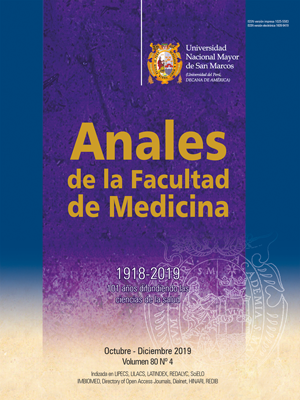Clinical pathological features of breast cancer associated with the expression of the Ki-67 cell marker at Edgardo Rebagliati Martis National Hospital, 2013-2017
DOI:
https://doi.org/10.15381/anales.v80i4.16746Keywords:
Cáncer de Mama, Antígeno Ki-67, Perú, Estudios Transversales, Factores de RiesgoAbstract
Introduction. Breast cancer is the third cause of death in peruvian women, a genetically heterogeneous disease, there are no studies on the behavior of the Ki-67 cell proliferation marker in this population. Objective. To analyze the association between the clinical pathological characteristics of breast cancer and the expression of the Ki-67 antigen in Hospital Nacional Edgardo Rebagliati Martins (HNERM), Lima-Perú. Methods. A retrospective study conducted in diagnostic samples of 209 patients with breast cancer. The clinical pathological characteristics were: age, histological type, tumor size, histological grade, lymphovascular invasion, axillary lymph node, clinical stage (TNMp), RE, RP, Her2+, triple positive, triple negative. The Ki-67 cell marker expression was categorized as low (Ki-67<20%) and high (Ki-67>20%). Results. High expression of the Ki-67 cell marker (>20%) was associated with tumors of 2cm, histological grade 2 and 3, greater number of axillary ganglia affected and Her2+ and triple negative inmunophenotypes. Low expression of Ki-67 (<20%) was associated with estrogen and progesterone positive tumors. Conclusion. The Ki-67 cell marker with high expression (>20%) shows a significant association with characteristics of poor prognosis well known in breast cancer.
Downloads
Published
Issue
Section
License
Copyright (c) 2019 Anales de la Facultad de Medicina

This work is licensed under a Creative Commons Attribution-NonCommercial-ShareAlike 4.0 International License.
Those authors who have publications with this magazine accept the following terms:
- Authors will retain their copyrights and guarantee the journal the right of first publication of their work, which will be simultaneously subject to Creative Commons Attribution License that allows third parties to share the work as long as its author and its first publication this magazine are indicated.
- Authors may adopt other non-exclusive licensing agreements for the distribution of the version of the published work (eg, deposit it in an institutional electronic file or publish it in a monographic volume) provided that the initial publication in this magazine is indicated.
- Authors are allowed and recommended to disseminate their work over the Internet (eg: in institutional telematic archives or on their website) before and during the submission process, which It can produce interesting exchanges and increase quotes from the published work. (See El efecto del acceso abierto ).



